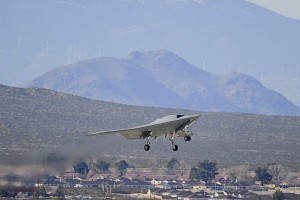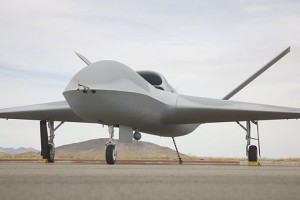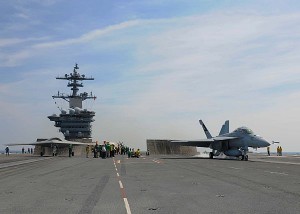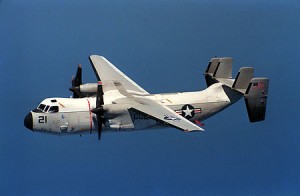 The fight over the Navy’s next-generation unmanned asset, the UCLASS, continues, with, as USNI’s Sam Lagrone reports, another delay:
The fight over the Navy’s next-generation unmanned asset, the UCLASS, continues, with, as USNI’s Sam Lagrone reports, another delay:
The final request for proposal (RFP) for the Navy’s planned carrier-based unmanned aerial vehicle (UAV) has been delayed pending a review of the service’s information, surveillance and reconnaissance (ISR) portfolio as part of the service’s budget process this fall…
It’s all a fascinating saga over a fight between two options–a high-end strike platform and a light maritime patrol bomber. They’re both great–Who wouldn’t want a crew-less super-high-endurance stealth penetrator? And who, these days, can do without a simple COIN-inspired, remotely-guided maritime ISR/patrol bomber/utility refueller?
They’re both needed, right?
Well…as much as America’s cash position argues for an incrementalist, flying-before-buying process that, oh, ensures the validity of those “boring-yet-vital” aspects of non-crewed airframes, it is time to bite the bullet and focus on making the supercarrier the home for exotic, high-end and longer-range stuff. Despite rumors that one contractor has an unfair advantage from prior work, let’s push our big four to meet the technical challenge of a long-range carrier-based penetrator.
An unmanned ISR/light strike platform does not need to fly off of carriers just yet…
 The Cost of An ISR/Patrol Bomber UCLASS is Too High
The Cost of An ISR/Patrol Bomber UCLASS is Too High
Admittedly, the no-frills ISR/Patrol Bomber UCLASS option is hard to resist. Yes, the supercarrier would certainly benefit from a low-end, simple patrol craft. And yes, a basic patrol craft is an achievable goal–almost an automatic win. And yes, a patrol craft/light bomber would be immediately useful. It’d be an obvious step for a community desperate to cast off the funds-sucking, stigma of the constantly-criticized F-35.
But…despite the prospect of easy wins, are the costs worth paying?
Hold on….Costs? What costs? Isn’t this supposed to be an automatic win?
Nope.
There are costs–just not super-obvious ones. But the costs are there. Putting an ISR/light strike patrol bomber on the carrier risks stifling innovation in an otherwise vibrant R&D scene. A carrier-based ISR platform will kill off (or just fatally challenge) the MQ-4C Triton–the still-developing land-based Broad Area Maritime Surveillance platform–and stifle interesting light strike ISR platforms and ISR concepts that are just beginning to percolate throughout the fleet.
No-crew ISR platforms should be protected as a space for nurturing new ideas/platforms/concepts–it’s one of a dwindling number of avenues for small, innovative players to enter the autonomous defense system business.
We all know what will happen if we go with the “easy” option–The moment this ISR/light strike mission-set becomes associated with a big carrier-flight-deck-bound “Program of Record”, all those interesting developmental platforms and ideas will evaporate. The UCLASS (and ONLY the UCLASS) will be allowed to “meet” the requirement–and because the Navy will have sold the low-end UCLASS as a prototype for something better, NOTHING will be allowed to threaten UCLASS.
An ISR UCLASS will kill off the cheap and innovative niche that unmanned ISR has become.
And that makes no sense.
The carrier doesn’t need a light-strike ISR platform clogging the flight deck right now.
BAMS is coming on-line (surely that can be rigged to carry a bomblet or two, yes?). And, well, aren’t the lower-end “pocket” flat-decks–the LHA/LHD/AFSB spaces–the appropriate place for ISR or COIN-esque light-attack surveillance UAVs anyway? With an explosion of USN AFSB-like platforms looking inevitable, there is going to be a lot of space for innovation in the ISR/light strike space. I mean, even the Independence Class LCS could, with some tweaking, serve to provide airspace surveillance during a big aircraft carrier’s 12 hour “off time”…there are a lot of platforms out there that might not have a traditional flight deck, but, in a pinch, will be able to support the carrier’s 12-hour off-time ISR needs AND support low-end innovation and prototyping. They need protecting.
When I’m in a cynical mood, I believe a low-end UCLASS protects the established aerospace “majors” by eliminating this nifty on-ramp for new ideas, new concepts–and potentially new competitors (General Atomics cracks a wry grin here). And, as an added bonus, by trumping the advanced UCLASS, the big aerospace companies eliminate a potential threat to the upcoming next-generation manned carrier aircraft competition (the F-35 showed us all just how good the manned strike aircraft business can be!).
The Navy gets some “benefits” by supporting a less-ambitious UCLASS too. Sure, the Service does get an immediately useful asset, BUT….it also foists the technical challenge of fielding a long-range penetrator off onto the Air Force (which–who knows? The Air Force may already have a good candidate hidden in some classified program someplace). A low-end UCLASS also hands the boring duties of refueling, patrolling and ground support off to some guy sitting in a recliner somewhere in Nevada, allowing the carrier-based fighter jocks to focus on their glamorous job of, well, being fighter jocks. And, finally, it sets America’s supercarrier CONOPs in amber, defusing the doctrinal challenge posed by capable, long-range UAVs to the queen of the fleet–the nuclear-powered supercarrier.
 Questions for the High-End Penetrator UCLASS
Questions for the High-End Penetrator UCLASS
I do like incremental development spirals–the progression of the Virginia Class sub from one production flight to the next offers a great example. But with un-crewed and very specialized platforms, I like the idea of pushing the envelope–and right now, in this period of relative peace and relative American maritime supremacy, is the time to do it.
Aside from the usual concerns about embarking upon another ambitious project, fated to follow in the footsteps of the behind-schedule and over-budget F-35-esque program, a deep-strike, stealthy UCLASS is disruptive, and comes freighted with some questions that probably should be discussed a bit more in open forums before a UCLASS RFP is released:
Will a strike UCLASS kill manned aircraft? Maybe. At least that’s the theory proposed by the UNSI newsers, here:
In particular, the change in UCLASS from a deep strike stealthy penetrator into the current lightly armed intelligence, surveillance and reconnaissance (ISR) focused aircraft was — in large part — to preserve a manned version of the F/A-XX replacement for the Boeing F/A-18E/F Super Hornet, several Navy, Pentagon and industry sources confirmed to USNI News.
Industry, Pentagon and Navy sources outlined a, “bureaucratic and cultural resistance to the introduction of unmanned aircraft onto the carrier.”
There’s nothing new here. We all accept that crewed aircraft are still needed, but uncrewed aircraft are inexorably marching to the fore. It’s still a debate that needs to be fleshed out, in public and far more often (It’s odd that stuff like Air-Sea Battle gets more oxygen….surely the march of un-crewed aircraft merits more urgent scrutiny than Air-Sea Battle…).
Can a strike UCLASS kill the supercarrier? Maybe. Look. Everybody agrees that America’s big aircraft carriers are too valuable to operate in a contested littoral environment. So, if we consider that close-in carrier strikes are a non-starter against a nation like, say, China, then yeah, it’s probably best to keep the supercarrier fleets far, far away from land, somewhere in the vast wastes of the Pacific, Antarctic or Indian Oceans. With that scenario in mind, it’s easy to see the value of a long-range, high-endurance strike aircraft.
But…when does this long-range, high-endurance strike craft eliminate the need for the carrier? I mean, imagine if the UCLASS program gives the Department of Defense some penetrating carrier-borne UAV with enormous range and the endurance to lurk almost anywhere. If that happens, then, well, why pay for 4.5 acres of American sovereignty as a base for those UAVs? If the added range is seen as nothing more than a means to protect a multi-billion-dollar asset–and to let the crew enjoy, say, the desolate and unmonitored Antarctic Seas, then why not just keep those UAVs in the air 24-7, orbiting the strike penetrators out of Okinawa, Guam, Diego Garcia and elsewhere?
It’s a question that merits some thought, particularly given the Navy’s ever-constant worry about the future of their constantly-challenged “Queen of the Fleet” supercarriers.
Does a strike UCLASS change the supercarrier mission? Yes. If standoff ranges are becoming so vast that strike platforms will need to be thousands of nautical miles “behind the lines”, then the only way the good-old supercarrier can justify fancy capabilities like, oh, super-fast sortie generation (remember, that’s THE prime selling point for the super-pricey Ford Class), is to become less of an initial “strike” weapon and more of an initial strike “facilitator” (injecting all those interesting ancillary platforms that support those first strikes on a prepared air-defense system), and post-first strike base (pumping sorties into the area compromised by the initial blow).
This question needs further community-wide discussion. If the penetrating UCLASS is only good if it is escorted by a whole bunch of jammers, escorts and so forth, then maybe it is wiser to focus on shorter-range airframes optimized to support longer-range stealthy strikers from (gasp) the Air Force. Or can the stealthy UCLASS airframe support those critical ancillary missions too? I dunno–but maintaining the idea that the long-range UCLASS needs support from shorter-range carrier assets makes no sense. (Well, maybe…about as much sense as sending in our fast, long-range MV-22s off on missions with slow, conventional rotary-wing gunships as escorts. But still we do it!)
Does a stealthy UCLASS make the carrier airwing extinct? Yes. UAVs can be migrants, wandering from carrier to carrier, offering some fascinating opportunities to change capabilities “on-the-fly”.
But Carrier Air Wings are woven into Navy culture and command pathways. Shift them, and you’re messing with the tectonic plates of the future Navy.
As an interim, if we really want to get unmanned aircraft on the carrier without fear of technical over-reach or ISR-light strike niche-poaching, then why not consider developing an unmanned Carrier Onboard Delivery aircraft? A high-priority cargo and air-to-air refueler offers a route to a cost-effective asset–and an asset of immediate use–for a niche that nobody is really eager to fill.
The timing is perfect. The C-2 Greyhound COD is a venerable aircraft, and it needs replacing–ASAP. Greyhounds are so old and so highly used, they’re simply falling apart.
Right now, an “updated” aircraft based on the old C-2 Greyhound airframe is battling it out with the MV-22. Now, I’m not saying that we should replace the old-school COD with an unmanned variant–The conventional COD carries too many passengers and sees too many different airports to entirely eliminate the pilot. But…surely there is room for an unmanned solution to share the load–particularly in moving heavy stores from established “hub-and-spoke” depots out to the carrier….and in serving as an air-to-air tanker in low-threat areas.
In my mind, while the big four work on the challenges of a high-tech UCLASS, there is ample room to develop something fast that can serve as both a heavy air freighter (Those big F-35 engines aren’t going to be schlepped around by the much-ballyhooed future MV-22 CODs anytime soon!) and air-to-air tanker. It’d get a long-range, unmanned platform on a carrier–letting the carrier work out how to interact with a UAV while also getting accustomed to a longer-range platform.
It would also give the aerospace majors an opportunity to start playing–right now–in the unmanned cargo delivery space–getting FAA approvals for operations gets a whole lot easier if you’ve been flying off of carriers and in-and-out of bases for awhile….and for that, I’d wager the aerospace majors would pay a premium.


{ 2 comments… read them below or add one }
Very good article. Spiral development is the way to go, especially for the command and control.
And like you I’m afraid if UCLASS settles on a minimalist platform, then that’s what the Navy will be stuck with for a generation.
But if we really want to accelerate the process, why use only two X-47B airframes to prove interoperability with manned aircraft and carrier flight decks? Right now, if one has an accident we lose half our carrier-compatible drones.
We have perfectly good carrier-qualified aircraft with docile flight characteristics, long range, bomb bays, and plenty of remaining flight hours not being utilized: S-3 Vikings sitting in the boneyard in Arizona.
Remove three of the four ejection seats and displays and all the remaining ASW gear. Then the plane can be “optionally manned” when needed; keep the radar and FLIR.
A QS-3 UAV with drop tanks and one bomb bay fitted with fuel tanks and the other with small PGMs would be perfect for long-range, Reaper-type missions.
Change the load out to both bays with fuel cells and underwing a drop tank and buddy pod and you would have a refueling UAV.
I believe if you want to break the cultural and technological barriers within the naval aviation community, as well as the Navy at large, getting UAVs out in good numbers needs to happen soon.
With distinct eastern European accent ‘Open ze bomb bay doors HAL’
With bland UAV robot voice ‘You know I can’t do that if you’re Dave because I can’t tell if I am being spoofed’.
While your crafting the plausible decisions / themes; its a reasonable expectation that mimicking the ‘amateurs talk strategy while pros talk logistics’ line that the future test of UAV competence will be the means of C2 and secure communications in contested environments and EMCON. The availability of AI that could mock HAL9000 as a ‘retard’ in the event of communications loss is another ‘not currently available’ issue.
That said; you are correct that a good decision space will be to parse the plausible roles for the MQ-4 (multipurpose e.g. bombs are ok) in concert with Carrier aviation as the BAMS mission space makes poor use of the airframe optimization as currently portrayed.